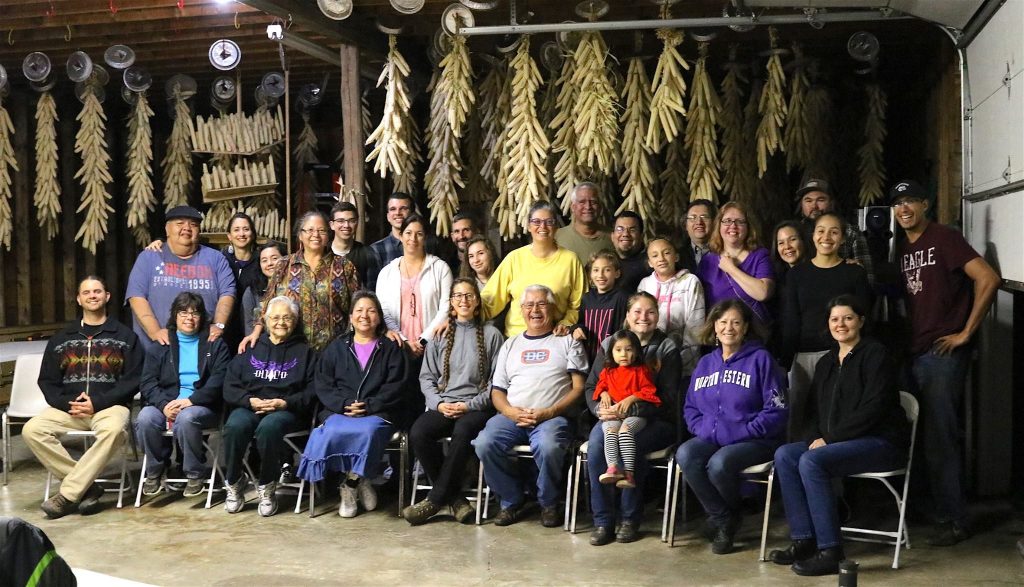Farmers have long relied on liquid fish fertilizers because they are a source burn-free nitrogen, phosphorus, and potassium. Traditional Native American growers were well aware of the benefits that decaying fish could bring to their soil; they buried fish under mounded soil and planted the 3 Sisters (corn, beans, and squash) directly on top of the mound. This traditional technique is well-known to Oneida Nation member and indigenous grower, Laura Manthe. Manthe, Coordinator for the Oneida White Corn Growers Group in Wisconsin, works with a group of growers who plant, harvest, and breed an heirloom variety of Iroquois White Corn. These Oneida community members, called Ohe.laku (OH-hay-lah-goo, [Among the Cornstalks]), were curious about modernizing their approach to traditional fish fertilizer by using fish emulsion to fertilize their white corn crop.
“We grow white corn because it is culturally appropriate for us to grow this variety of corn as we are Haudenosaunee, or the Original People, and this corn is part of us,” said Manthe. “We selected fish emulsion because we wanted the benefits of fish fertilizer without the physical task of burying thousands of fish on three acres of land.”
With support from a $17,637 NCR-SARE Farmer Rancher grant project, the White Corn Growers Group and several backyard growers set out to build their cultural knowledge about white corn, and to learn how to use fish emulsion to fertilize it. During one of their monthly project meetings, they met with Val Dantoin, an organic agriculture instructor at Northeast Wisconsin Technical College, who shared information about soil health and helped them take preliminary soil tests to determine deficiencies in their soil. They determined that some of their soil deficiencies could be addressed with fish emulsion. Making fish emulsion involves cooking the by-products of cleaned fish at temperatures in excess of 180°F, filtering it, and stabilizing it with an acid (a rather “stinky” process according to Manthe); so the group chose to purchase their fish emulsion. Then they went about fabricating spraying equipment, and pooling enough white corn seed to plant 3.5 acres. Planting day commenced with a traditional tobacco ceremony. As they planted the corn, children picked rocks, planted squash seed around the edges of the field, pulled weeds, and sang along to a planting songs CD that Manthe had acquired from the Oneida Cultural Heritage Department.
“We played the songs on a boom box and sang along as the seeds were being planted,” recalled Manthe. “The songs are as old as the seeds, and are a part of our culture.”
Tough weather and a group of persistent raccoons took a toll on the crop over the course of the project, but Manthe said the white corn growers were convinced that the fish emulsion was a determining factor in the health of the stalks and the size of the cobs. One grower, Becky Webster, was amazed at the difference between the sprayed and unsprayed corn.
“They had side-by-side corn stalks that were sprayed and not sprayed,” explained Manthe. “The corn stalks that were sprayed were tall, dark green, and had huge corn cobs on them. The corn stalks that were not sprayed were spindly, light green, and had small skinny corn cobs that did not yield any corn.”
When the moisture content of the corn reached 35%, it was time to harvest. As part of their harvest in 2017, they hosted an event called “Braiding the Sacred.” he corn was hand-harvested and shucked down to three husks. The cobs were hand-braided using 65 cobs to make each braid. The group made 250 braids (20.30 lbs each) of white corn which were hung to dry. Native Americans from around the Great Lakes gathered for this event to learn about harvesting white corn and to better understand their spiritual connection to the crop. Once the harvested corn reached 11% moisture, the braids were divided among the growers for them to hand shell at home. They set aside some of their crop for next year’s seed and donated some to the community to prepare for funeral meals.
“We felt that was the best way to share our harvest and fulfill our responsibility to each other,” explained Manthe.
In order to develop community understanding of white corn, each original member was allowed to invite one person into the group, under their wing. These “wingers” had the opportunity to receive a portion of the harvested crop, and could become a full member. Manthe also created two Facebook pages, one for the corn growers and another to share the story of the white corn project with community members. Building community was a cornerstone of the project.
“I got to spend more time with my family and we did community building,” reported Eliza Skenandore one of the participating growers. “I did this for my son who is three years old. He knows where the field is. He wanted to visit it every time we drove close to it. I got to share cultural knowledge with the group and see it come alive.”
